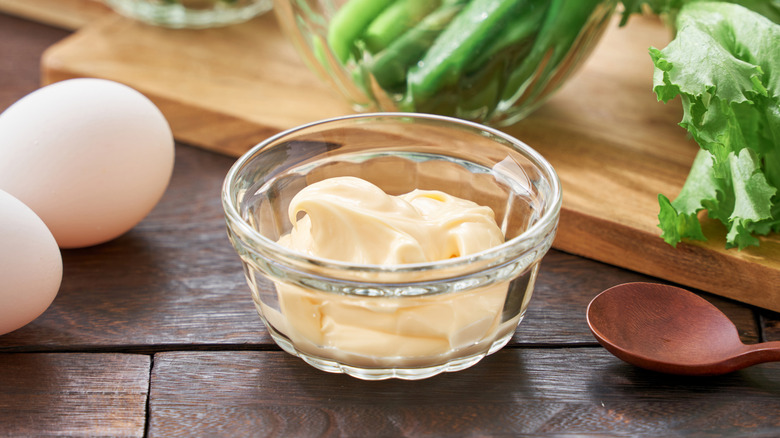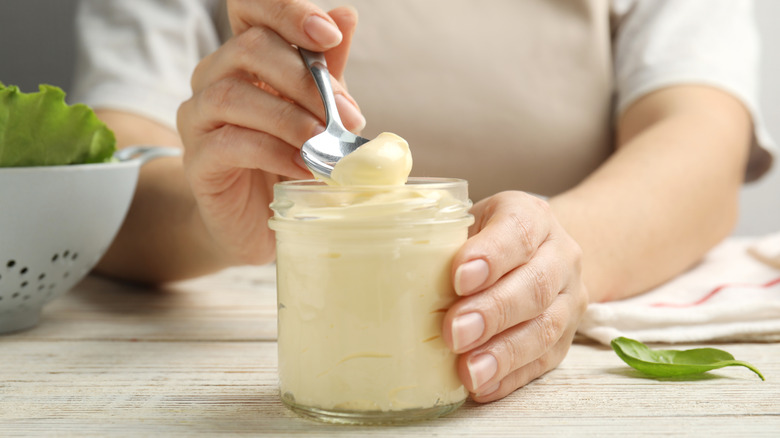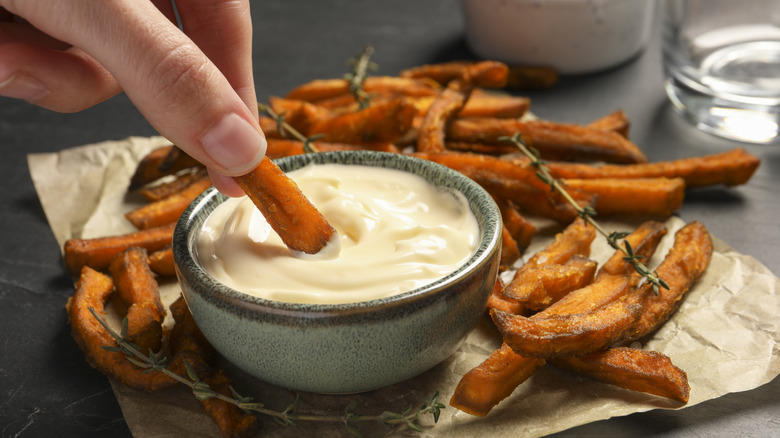How Long An Opened Jar Of Mayo Lasts In The Fridge
Few condiments are as versatile and beloved as mayonnaise; it pairs perfectly with fries, works as a creamy base for dressings, and can even take boxed cake mix from dry to delicious. It's also endlessly customizable; just add garlic and lemon juice to create a homemade aioli, or stir in herbs for a fresh, new flavor. But once cracked open, how long does a jar of mayo last? To find out, Food Republic consulted Helen Tieu, registered dietitian and founder of Diet Redefined, who revealed that "once opened, most commercial store-bought mayonnaise lasts for two months in the fridge if stored and sealed properly."
This surprisingly long shelf life comes down to the way commercial mayo is produced. The ingredients include acidic compounds like vinegar or lemon juice, preservatives, and pasteurized eggs (eggs that have undergone a heat treatment to kill harmful bacteria), which all work to extend shelf life by inhibiting the growth of bacteria and mold.
While homemade mayo and store-bought mayo each have different flavor profiles and uses, they're also distinguished by their shelf life. Homemade versions are simple, cost-effective, and usually fresher. However, as Tieu noted, homemade mayo "typically has a much shorter shelf life of [three to five] days." This is because most amateur home cooks don't have access to pasteurized eggs or the preservatives used in commercial production. If you want to extend the shelf life of your homemade mayo, consider using liquid eggs, which are required to be pasteurized, instead of shelled.
Signs that your mayo has spoiled
While most commercial brands of mayo typically have a long shelf life, spoilage is inevitable. An unopened jar of mayo can last over a year, but once opened it's immediately exposed to air, causing oxidation — a process that gradually breaks down its quality and freshness. According to Helen Tieu, there are several clear signs of spoilage to look out for.
"A sour, rancid, or off-odor smell," Tieu explained, is the earliest warning sign. Smelling bad is our body's evolutionary defense against spoilage, though appearance also offers clues that your mayo should be discarded. For instance, a "color [change] from light yellow to a darker or gray [hue]" is a direct sign of oxidation, particularly from the oils breaking down on exposure to air. A more obvious sign of spoilage is mold. While it might seem tempting to scrape off the top layer, mold can spread invisibly beneath the surface, so even if the rest of your mayo looks fine, we recommend tossing any jar with signs of mold.
Another sign of spoilage is textural changes, such as a "watery or curdled consistency, or separation that does not mix back together," Tieu told us. These changes happen because the emulsion in mayo — the stable blend of oil, egg yolk, and an acid — has broken down. Over time, certain ingredients no longer held in the emulsion can degrade, causing an unpleasant texture.
The best way to store mayo for maximum freshness
Once a jar of mayo has been opened, it immediately begins to lose freshness, but smart storage can help prolong its shelf life. "After opening, keep mayonnaise in the fridge at or below [40 degrees Fahrenheit], tightly sealed in its container," Helen Tieu told us. While store-bought mayo can technically sit at room temperature without spoiling, refrigeration is best for preserving quality. "Store mayonnaise in the main compartments of the fridge, rather than at the door, where temperature fluctuates more," she advised.
Homemade mayo requires stricter care. "Always keep homemade mayonnaise refrigerated," Tieu recommended, since it contains raw eggs and no preservatives, making it far more perishable. To extend its life, minimize air exposure by storing it in an air-tight container and keeping it away from light. You should also "make homemade mayonnaise in small batches," she suggested, which not only helps avoid waste but keeps a steady rotation of fresh mayo on hand, reducing the risk of spoilage.
Even with store-bought mayo's longer shelf life, contamination is an easy way to shorten it and cause premature spoilage. "Use clean utensils each time you use the mayonnaise," Tieu told us. Dirty spoons or knives can introduce bacteria into the jar, and the same goes for double-dipping. "Avoid keeping mayonnaise on the counter at room temperature for more than two hours," Tieu added, since warmer conditions speed up oxidation by breaking down oils.



